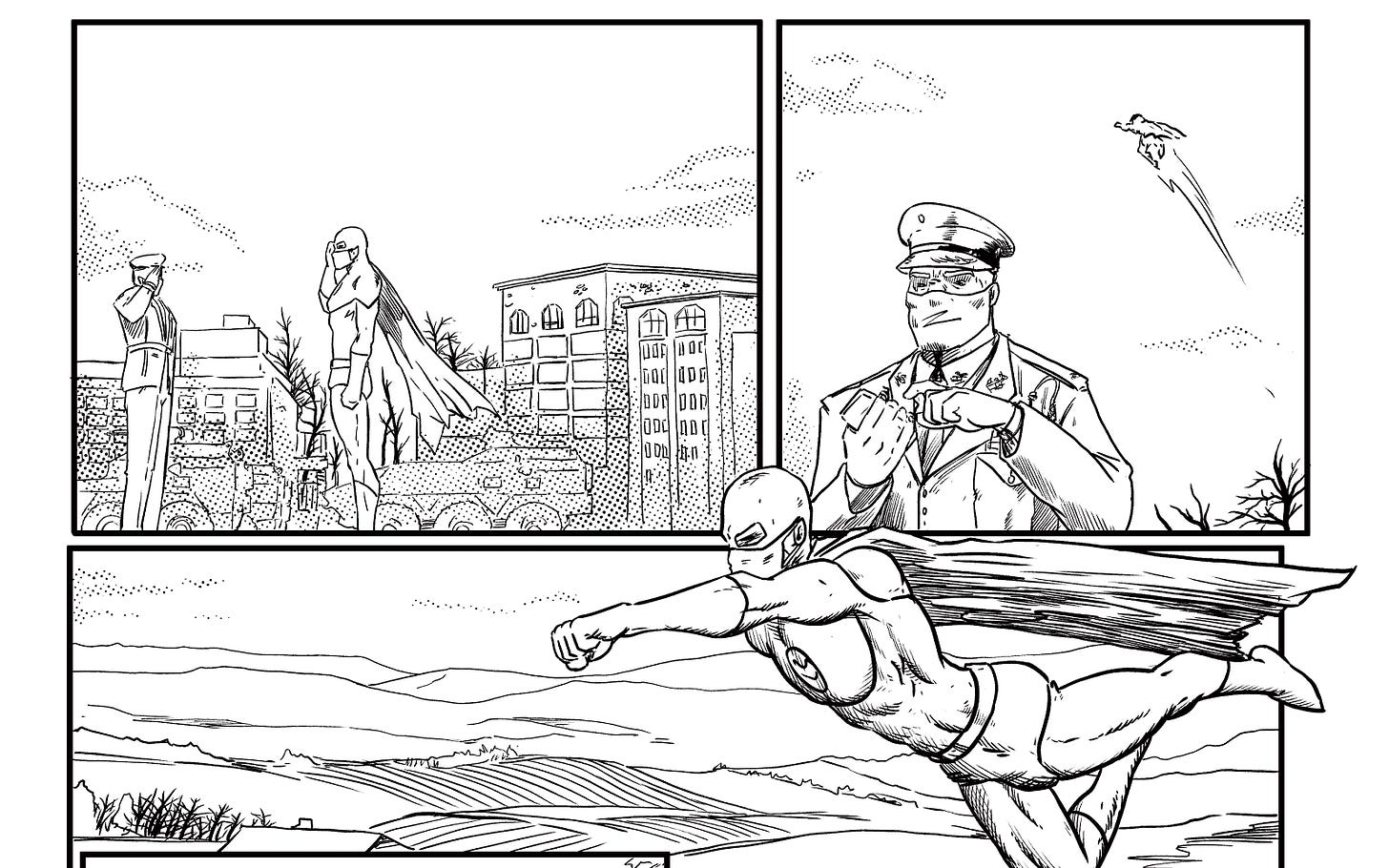I’m done writing prose for a while. At least that’s what I keep reminding myself. Those pesky ideas keep squatting on the real estate of my mind.
But with grim determination and a stiff upper lip, I drive on.
I’m still coloring and lettering, and I’ve got a long way to go. Out of approximately 110 pages, Luke has now inked over 70.
I have colored and lettered 20 and counting. Yesterday was a sort of experiment. Aside from a couple breaks to eat, take care of the dogs, and curate the crowdfunding campaigns I’m backing, all I did Saturday was color and letter. That got me through two pages.
And it used to take even longer.
I learned a few tricks along the way, and also how to protect previous work better. In the early days, after finishing one panel I would move on to the next without looking at the first one again. Unknown to me, when multiple panels are on the same layer (as is the case when Luke illustrates), something I color in Page 43, Panel 4, can screw up the colors on Page 42, Panel 2. Going back to fix it means undoing 500 steps by the time I catch it—if CSP will let me go back that far. Then all the other work I’ve done since then is lost. So in some of the first pages I colored, you’re gonna see some wonky stuff. It looked better originally, but it is what it is, now. This is taking too much time already—I’m not going back to start almost from scratch.
Then there was this:
In the future, if I have to color the inks from the artist, I’m gonna request that they do no crosshatching and other shading. All the millions of maverick pixels that won’t accept color from the paint bucket when two lines are close together is just maddening—and is taking more time than anything else right now.
I’ve also got the opposite problem: line art that is not closed off, so that color from the paint bucket spills out of the drawn object I’m trying to color and covers a bunch of other stuff. I now wind up doing hours of prep work (closing all the lines which don’t quite connect) before I can even start coloring—and I inevitably miss stuff that I must fix on the fly later, further slowing me down when I forget to switch back to the color layer, etc.
This is a long slog. Though I’m making progress on the graphic novel, my writer’s mind is brimming with story ideas new and old, and upset that I’m not making progress on any of them.
I’m taken aback at how expensive and time-consuming everything is in comics. Yet it takes hardly any time to read the finished product. It’s amazing how much sequential art is published all the time, considering the work that goes into it and what must be a heartbreaking return on investment.
Know what else is astounding? All the crowdfunding campaigns with goals of only $300, or $700. That can’t possibly be profitable. In fact, the creators probably can’t even just break even like that.
Keep watch, frens. When I have enough finished pages to provide a buffer, I’ll start sharing panels here, and on Arkhaven, and my blog.
Why would I share stuff for free that was so costly to make? In the hopes that it will attract a lot of readers who will back a campaign to get printed copies of Threat Quotient when I’m ready to pull the trigger.
This is not a one-off. Threat Quotient is just the first in a series of at least four graphic novels I hope to produce. And after that, I want to do several spin-off titles wherein the characters in this superhero ensemble undertake solo adventures. I’m introducing a pantheon with this series, and want my own publishing enterprise. The VPU (Virtual Pulp Universe) has a nice sound to it. But I need substantial success for this first graphic novel if any of the follow-up projects are to have a chance.
The fate of a fledgling comics empire hangs in the balance.




As you've probably seen I've been looking into automated illustration lately (I know you looked at Murder on the Stellar Schooner, and my latest book "Illustrated CONAN Adventures: The Phoenix on the Sword" https://www.amazon.com/dp/B0DQTF6NRT has about 80 algorithmically generated illustrations)
It seems to me that automating colorizing panels isn't too hard, and you could in practice just color a few pages and have a model juxtapose those with the remaining pages and inpaint the white areas on the uncolored page in a way that matched the existing style on the previously colored pages.
It looks like CSP already has some auto-colorizing tech, as well as crosshatch/shading removal: https://help.clip-studio.com/en-us/manual_en/390_filters/AI_Tools.htm#1364086
Though this appears to color pages individually, rather than use one page to color another as I'd probably implement.
Anyway if you have stuff you hate the coloring of you'd like me to try as a testcase, I'm up to see if the problem is particularly solvable by the above approach!
One thing I do to color other people's lineart is to copy-paste the lineart to a new layer. Set it to multiply, which makes all the white transparent. Then do all your coloring on the layer beneath. Select everything with the magic wand or lasso. You can draw funky shapes beneath the lineart and fill them in. That way the lineart stays clean and untouched, and all the messy coloring is on its own layer.